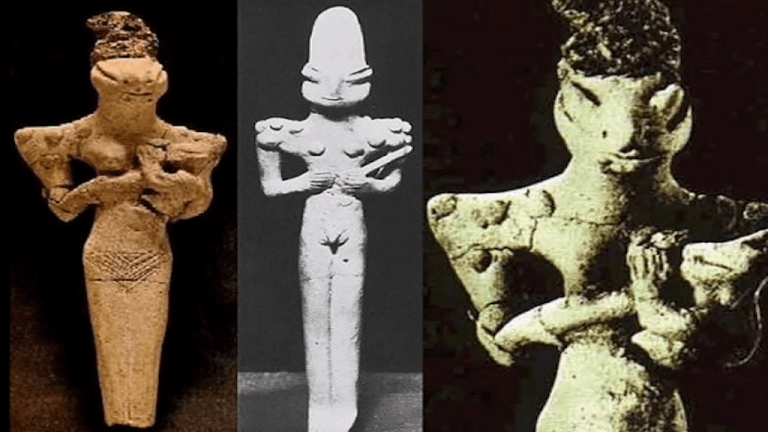
Ancient Reptilians: The Unanswered Mystery of The 7,000 Year Old Ubaid Lizardmen
Archaeologists excavating in Iraq at the beginning of the 20th century made an unusual discovery when they unearthed several 7,000-year-old artefacts which appear to represent humanoid figures with reptilian features.
By: Nathan Falde | Ancient Origins
It is a commonly accepted view in mainstream archaeology that civilization started in ancient Mesopotamia with the great civilization of Sumer in what is now modern-day Iraq. However, at the beginning of the 20th century, archaeologists excavating at Tell Al’Ubaid in Iraq made an unusual discovery when they unearthed several 7,000-year-old artefacts which appear to represent humanoid figures with reptilian features.

Understanding Ubaidian Culture
The Ubaidian culture is a prehistoric culture in Mesopotamia that dates between 4000 and 5500 BC. As with the Sumerians, the origins of the Ubaidian people is unknown. They lived in large village settlements in mud-brick houses and they had developed architecture, agriculture and farmed the land using irrigation.
The domestic architecture of the Ubaidians included large T-shaped houses, open courtyards, paved streets, as well as food processing equipment. According to the Metropolitan Museum of Art, some of these villages began to develop into towns, temples began to appear, as well as monumental buildings such as in Eridu, Ur and Uruk, the major sites of the Sumerian Civilization. Sumerian texts explain that Ur was believed to be the first city.

Discovering Ubaid Lizardmen Figurines At Tell Al’Ubaid
The main site where the unusual artefacts were discovered is called Tell Al’Ubaid – although figurines were also found in Ur and Eridu. The Al’Ubaid site is a small mound of about half a kilometre (0.3 mil) in diameter and two meters (6.56 ft) above ground. First excavated by Harry Reginald Hal in 1919, male and female figurines were found in different postures. Most of the figurines appear to be wearing a helmet and have some kind of padding on the shoulders.
Other figurines were found to hold a staff or sceptre, possibly as a symbol of justice and ruling. Each figurine has a different pose but the strangest of all is that some female figurines hold babies suckling milk, with the child also represented as a lizard-type creature.

Ubaid Lizardmen: The Prehistoric Lizard Figurines
The figurines are presented with long heads, almond shaped eyes, long tapered faces and a lizard-type nose. What exactly they represent is completely unknown. According to archaeologists, their postures, such as a female figure breast-feeding, do not suggest that they were ritualistic objects. So what did these Ubaid lizardmen represent?
12,000 Year Old Massive Underground Tunnels Are Real And Stretch From Scotland To Turkey
Whatever they were, they appear to have been important to the ancient Ubaidian people. We know that the serpent was a major symbol used in many societies to represent a number of gods, for example, the Sumerian god Enki, and the snake was used later on as the symbol for the Brotherhood of the Snake, supposedly an ancient secret society. Is there a link between the symbol of the snake and the representations of lizards? For now, these questions remain unanswered.
* * *
NEXT UP!
Magellan’s Strange Encounter With The 10-Foot Giants of Patagonia
IN 1520, FERDINAND Magellan took time out of his busy schedule of sailing around the world to stop in what is now Patagonia, where he found a naked giant dancing and singing on the shore. Magellan ordered one of his men to make contact (the unwitting emissary’s no doubt hilarious reaction to this sadly has been lost to history), and to be sure to reciprocate the dancing and singing to demonstrate friendship.
It worked. The man was able to lead the giant to a small island offshore, where the great captain waited. Describing the scene was a scholar along for the journey, Antonio Pigafetta, who kept a diary of the journey that was later turned into the book Magellan’s Voyage: A Narrative Account of the First Circumnavigation: “When he was before us, he began to marvel and to be afraid, and he raised one finger upward, believing that we came from heaven. And he was so tall that the tallest of us only came up to his waist,” and had a big, booming voice. The illustration above proves it—Patagonia was once inhabited by giants that positively dwarfed the heavenly Europeans that would come to conquer them.
Alright, maybe that isn’t airtight evidence. But it could well be that the people Magellan encountered, the Tehuelche, were indeed enormous, and that therefore this myth has some grounding in reality. And our trusty explorer would be damned if he wasn’t going to try to bring back evidence in pretty much the most obnoxious way you could imagine.
* * *
READ MORE: Uruk, The First Great City: A Leap Forward For Humankind?
Read more on Forbidden History: Icy Atlantis: Does This Mysterious Dome Structure Hidden In Antarctica Reveal A Lost Ancient Civilization?
Telegram: Stay connected and get the latest updates by following us on Telegram!
We’d love to hear from you! If you have a comment about this article or if you have a tip for a future Collective Spark Story please let us know below in the comment section.

breasts aren’t a reptilian feature.